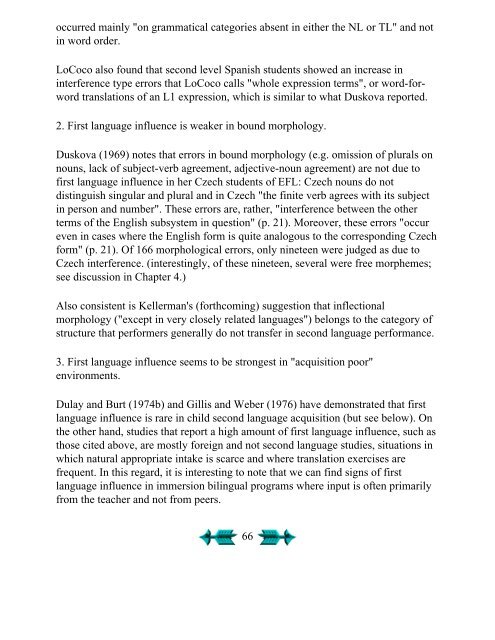Second Language Acquisition and Second ... - Stephen Krashen
Second Language Acquisition and Second ... - Stephen Krashen
Second Language Acquisition and Second ... - Stephen Krashen
You also want an ePaper? Increase the reach of your titles
YUMPU automatically turns print PDFs into web optimized ePapers that Google loves.
occurred mainly "on grammatical categories absent in either the NL or TL" <strong>and</strong> not<br />
in word order.<br />
LoCoco also found that second level Spanish students showed an increase in<br />
interference type errors that LoCoco calls "whole expression terms", or word-forword<br />
translations of an L1 expression, which is similar to what Duskova reported.<br />
2. First language influence is weaker in bound morphology.<br />
Duskova (1969) notes that errors in bound morphology (e.g. omission of plurals on<br />
nouns, lack of subject-verb agreement, adjective-noun agreement) are not due to<br />
first language influence in her Czech students of EFL: Czech nouns do not<br />
distinguish singular <strong>and</strong> plural <strong>and</strong> in Czech "the finite verb agrees with its subject<br />
in person <strong>and</strong> number". These errors are, rather, "interference between the other<br />
terms of the English subsystem in question" (p. 21). Moreover, these errors "occur<br />
even in cases where the English form is quite analogous to the corresponding Czech<br />
form" (p. 21). Of 166 morphological errors, only nineteen were judged as due to<br />
Czech interference. (interestingly, of these nineteen, several were free morphemes;<br />
see discussion in Chapter 4.)<br />
Also consistent is Kellerman's (forthcoming) suggestion that inflectional<br />
morphology ("except in very closely related languages") belongs to the category of<br />
structure that performers generally do not transfer in second language performance.<br />
3. First language influence seems to be strongest in "acquisition poor"<br />
environments.<br />
Dulay <strong>and</strong> Burt (1974b) <strong>and</strong> Gillis <strong>and</strong> Weber (1976) have demonstrated that first<br />
language influence is rare in child second language acquisition (but see below). On<br />
the other h<strong>and</strong>, studies that report a high amount of first language influence, such as<br />
those cited above, are mostly foreign <strong>and</strong> not second language studies, situations in<br />
which natural appropriate intake is scarce <strong>and</strong> where translation exercises are<br />
frequent. In this regard, it is interesting to note that we can find signs of first<br />
language influence in immersion bilingual programs where input is often primarily<br />
from the teacher <strong>and</strong> not from peers.<br />
66











